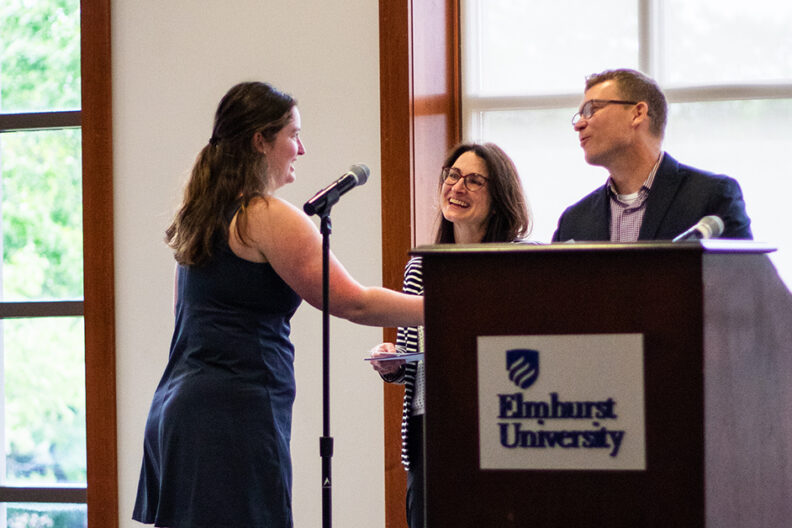Engaging Families in Schools Today
Chalking the Line | By LINDA DAUKSAS | 7 MIN READ

“Family engagement is the process used to build genuine relationships with families. Relationships with families support overall family well-being and children’s healthy developments. When families are engaged, partnerships are created that have a common focus-helping children grow and thrive.”
-U.S. Department of Health and Human Services (2021)
Teachers today have many objectives. They are required to focus on effective teaching, fidelity of curriculum implementation, administering assessments, creating classroom management systems, becoming content experts and practicing pedagogical skills.
However, an essential skill for today’s responsive teacher is knowing how to honor and collaborate with students’ families. Over 50 years of research has shown that strong family engagement in schools is an indicator of effective schools and teachers. “This research confirms that family engagement is one of the most powerful predictors of students’ development, educational attainment and success in school and life.” (Global Family Research Project, 2018)
What are Engaging Families?
To discuss family engagement, we must first define these terms. For decades, schools worked with parents. Today’s paradigm is families. Students today are surrounded and supported by a variety of family structures (e.g., single moms/dads, blended families, foster families, two moms or two dads, grand families, etc.). These structures may or may not include the student’s parent(s). Currently defined, a family might be a group of one or more parents and children, not defined by blood or yet living together. Others might say family is having a relationship with a group that is safe and supportive, with no mention of living arrangements. These broad definitions represent and honor the diverse families of today’s students.
For decades, schools worked to get volunteers involved in classrooms or at school-based events. Involvement implies “doing to” and joining in under the supervision of the teacher or administration. Today’s goal is to engage families. Engagement implies “doing with”. Engagement honors families and their abilities to become the creators of information, the facilitators of knowledge and the designers of activities. Making the shift from parent involvement to family engagement means altering ways of knowing and doing.
Why Is Engaging Families Important?
Family engagement yields many benefits for stakeholders. When families are engaged students earn higher grades, are less likely to be retained in a grade and schools are more apt to have an accurate diagnosis for educational services. When families are engaged students attend school regularly, have better social skills, have fewer negative behavior reports and are more likely to graduate and go on to postsecondary education. Engaged families tend to have more positive attitudes towards schools/teachers, gain a better understanding of their child’s skills and development and experience an increase in their own skills and autonomy related to the educational experiences. Engaged families may even take on leadership roles in the schools.
The benefits to schools include better performance on high stakes testing, more likely to achieve standards and accountability requirements, greater likelihood of having school bond issues approved and involvement in grant-writing initiatives (Grant and Ray, 2024). According to Mapp and Bergman (2021) schools with engaged families more effectively navigated remote learning and school closures during the COVID 19 pandemic. To maximize the impact of family engagement we must acknowledge and attempt to minimize existing barriers.
Barriers to Engaging Families
For families, time is a huge obstacle and can make engagement difficult. Limiting the hours of an event to the traditional school day make it impossible for some families to attend. Sara Lawrence Lightfoot (2004) also captures the “ghosts in the classroom” that exist for some family members. These “ghosts” are personal, negative school experiences which make going back into schools and engaging in activities less than desirable. Across the country, school policies and procedures supporting engagement often reflect the dominant culture’s Eurocentric middle-class values creating uncertainty or unwelcoming feelings for some families. For example, including meals may eliminate a family’s participation when their culture or religion does not allow them to eat certain foods; holiday celebrations of the dominant culture may not coincide with a family’s beliefs or religion thus prohibiting them from attending. Some cultures also believe it is the responsibility of the teacher to educate. While the family’s responsibility is to rear the child at home thus limiting their presence or engagement.
For schools, one long standing barrier to engaging families is an administration that does not prioritize engagement or possesses a “deficit-based view” of families. The deficit perspective includes believing that families are not able to do, do not know, or do not care about their child’s education (Mapp & Bergman, 2021). School personnel’s lack of trust or respect for families’ choices also creates negative attitudes (Adams & Christenson, 2000). It is also noted that middle-class teachers tend to view low-income families negatively as far as valuing the family’s contributions or child-rearing practices (Arce, 2019; Edwards & Young 1990). Some teachers also fear families will judge their teaching abilities if they are present in the classroom. And for some, the teacher’s mounting responsibilities makes finding time to engage families a low priority.
Communication
Communication is a barrier that exists for both schools and families. The diversity of languages and delivery modes present in society offer both obstacles and opportunities for communicating and building relationships today. Some school districts are serving as many as 90 different languages. Although this presents challenges when communicating, it also presents rich opportunities to learn about the cultures and traditions.
Security Barriers
Albeit necessary, today physical barriers are present on campuses and in school buildings. Locked doors and the expectation family members present specific identification (e.g., state identification or driver’s license), criminal background checks or evidence of vaccinations lessens the number of families coming into schools. Additional school procedures may limit the number of family members (e.g., only one family member), or the ages of family members (e.g., no younger siblings) attending events.
Working Through Barriers
Recognizing these barriers exist and bringing all stakeholders together with the goal of creating inclusive, responsive learning environments are the first steps to fostering a culture of family engagement. Prioritizing families and looking beyond the walls of the school to seek cultural brokers (Lightfoot, 2004) within the community helps cultivate understanding among stakeholders. Developing an opportunity versus obstacle perspective will help generate new ways of knowing and doing. Providing professional development, adding resources and roles to fortify relationships among stakeholders and ultimately greater family engagement will generate more positive outcomes for students and support the development of a community where everyone is learning. Working with students’ families is not an option. Research has confirmed that “educators need to know how to work with families and communities”. These competencies are required every day of every year of every teacher’s professional career (Epstein et al., 1999, p.29).
Get Involved
At Elmhurst University students majoring in early childhood education take a semester long course centered on working with families. Other education majors take this course as an elective. If you would like to learn more about the Education Department at Elmhurst University, please fill out the form below.



